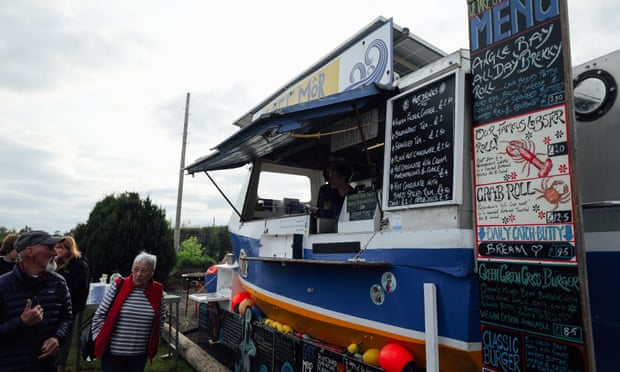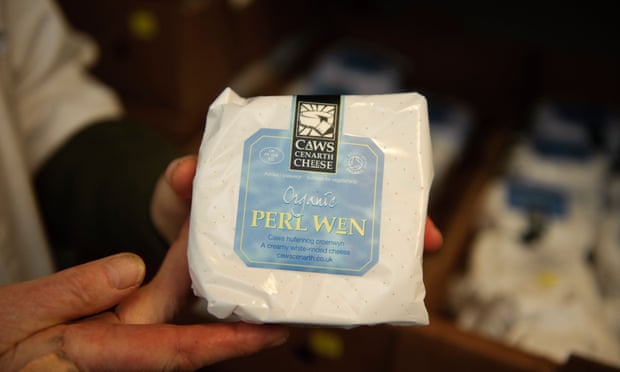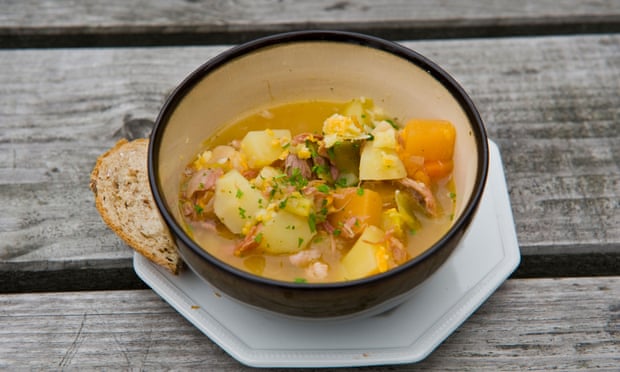
Traditional Welsh food has for some time suffered something of an image problem, even among the Welsh themselves. Despite Richard Burton calling laverbread the “Welshman’s caviar”, when Welsh patriot Annie Haden put on a traditional menu in a 2009 episode of Come Dine With Me in Dylan Thomas’s childhood home, the guests were distinctly unimpressed.
Things are changing however, as Wales’s peasant foodways get rediscovered. From laverbread (seaweed) to ewe’s cheeses, oysters and cider to salted butter and saltmarsh lamb – and umpteen different ways with oats – the hallmarks of this peasant cooking are quality ingredients, prepared well.
George Borrow, the English writer who travelled widely across Europe, wrote in an 1862 travelogue: “For dinner we had salmon and leg of mutton; the salmon from the Dee, the leg from the neighbouring Berwyn … beats the leg of mutton of any other country …”
A century earlier, another English traveller in Wales described the diet of the common people of Anglesey as consisting of “little meat, but … cheese and butter, bacon, tame and wild fowls, sea fish, oysters, crabs, lobsters … mussels and cockles”. And studies into poverty and health in interwar south Wales remarked on the custom of frying laverbread – made from seaweed, one of the most nutrient-dense plant foods around – in bacon fat and serving it with bacon, usually as a delectable weekend breakfast.
These are all food products deeply rooted in the landscape and its people. Some Welsh ingredients have barely hung on into the 21st century, victims of the globalisation of food and perhaps the lack of celebrity champions. Where they have survived has tended to be as a linchpin of home cooking or in humble cafes and pubs.
But these varied culinary practices are now enjoying a long-overdue renaissance, and making an appearance on the fine dining scene, at places like Annwn Restaurant in Pembrokeshire. Meanwhile, small producers across the country are cultivating heritage varieties and reviving old ways of producing good simple produce like bread, cheese and cider. Food culture is being rediscovered and revitalised. Here are four tours to savour the broad range of food and drink produced in Wales.
Cider in the marches
Wales has dozens of traditional apple varieties, and the first written reference to cider making here was in the 13th century. Many of the Welsh varieties have traditionally been used to produce a notably fruitier cider than that made in Somerset. A growing number of cider makers are resurrecting these flavours, and the cider they make (nothing but fermented apples and water) is truly a product of its terroir.
Most of this mountainous cider country can be explored in a day, following the territories of the Marchia Wallia (Welsh marches), controlled for centuries by the Norman barons who first brought the drink here, perhaps reminded of their northern French home.
Start just outside the genteel town of Cowbridge, at the Hare & Hounds, which has Llanblethian cider on tap – perhaps at the end of a circular walk taking in the orchard where the apples are grown, next to the River Thaw.
Head east through the gentle climes of the Vale of Glamorgan and into Monmouthshire, the heart of Welsh cider country. Enjoy a pint of local Palmer’s Upland Cyder to live music at The Cellar Door pub in Newport, before following the A479 north through the sheltered vales of Norman Wales, where farm labourers were traditionally paid in cider.
Stop at Watson’s Ale House in Knighton, which stocks Skyborry from down the valley, then continue to the mountainside orchard of Welsh Mountain Cider near Llanidloes, where the sound of the accordion and a tipple in hand will convince anyone: Wales makes great cider, and great cider can hold its own against any (white) wine.
Coast path seafood ramble

Hiking the 53 miles of the Wales Coast Path from Freshwater West to Carmarthen takes in some of the best food this glorious region has to offer. The Pembrokeshire coast is laver country, and Freshwater West beach used to be famous for its rows of seaweed-drying huts. Cafe Môr, in the garden of the Old Point House, near Angle village, is one of the country’s best seafood shacks, where the delicious tradition of serving laverbread with local bacon is very much alive.
Walk on east and, as you come into Tenby harbour, stop at Simply Seafoods fishmongers for a lunch of local cooked shellfish, or crab or lobster sandwiches.
As you head east from Saundersfoot, the cliffs soften into broad expanses of sand and you enter cockle country. Dylan Thomas enjoyed the cockles in Laugharne (where the town chippy still serves them in vinegar), but you’re on your way to a farmhouse kitchen in quayside Carmarthen.
Pantri Blakeman is a gem of a place, serving bacon and cockles on toast or the ultimate trio of laver, cockles and bacon with fried bread. In an era where the need to eat less meat is widely acknowledged, it makes you wonder why more than 90% of the Welsh cockle catch is exported.
Teifi valley cheese tour

In the 19th century, dairy women and men went from Ceredigion to London in their droves, and the county’s dairy tradition still prospers – the Teifi valley, with its lush pastures, is home to some of the world’s finest cheeses.
If travelling here from the south or east, stop at the Welsh Rarebit Centre en route, before heading to Y Talbot in Tregaron, where several local cheeses are woven into the menu.
In Lampeter be sure to stop at Watson & Pratts to buy the local, heavenly Hafod cheddar before going on to visit Caws Teifi (the most highly awarded artisan cheesemakers in Britain) at Glynhynod farm outside Llandysul for a mouthwatering array of raw, organic cheeses.
Several miles of towering hedgerows and sunken lanes later and you come to Glyneithinog, home of Caws Cenarth. Here, the tradition of farmhouse Caerphilly cheese continues unabated, accompanied now by the revival of Welsh sheep’s cheeses (Dol Wen, Dol Las), celebrated in the 18th century and now available once more.
If you have a day or two for a detour, widen your range and loop back on yourself by following one of neighbouring Carmarthenshire’s larder trails. Either way, finish off at the foodie focal point that is perfectly formed Cardigan, where you can sleep and walk it all off by the sea, before tucking into brunch at Crwst (complete with local halloumi).
The cawl crawl

Cawl is the Welsh dish par excellence, a stew combining pasture-fed lamb, mutton or beef with leeks, root veg and crusty bread. There are plenty of good pubs to sample cawl (including Pitch in Cardiff, the Stackpole Inn in Pembrokeshire), but the best way to taste the dish is by sourcing your ingredients from their natural landscapes and making it yourself.
Start among the towering peaks of Snowdonia, at Blas ar Fwyd deli in Llanrwst, where you could buy ready-made Lobsgows (the north Walian variant of the dish), or better still, pick up some Welsh black beef or neck of lamb at Bodnant Welsh food centre. Head south, and as you pass through this mountain country reflect on the fact that the solid 16th-century stone houses dotting the slopes were built with the wealth from the drovers’ trade in beef cattle.
Crossing the ancient border between Gwynedd and Powys, the landscape changes. This is (marginally) better country for grain, and after decades of neglect locally grown, milled and baked Welsh loaves are readily available – try Torth Dyfi or the Felin Ganol wholemeal from Rye and Roses bakery in Machynlleth.
Keep the coast on your right and continue south; you have left the mountains behind by now, and can pick up the finest organic leeks (and onions, garlic, swede, carrots and potatoes) from Blaencamel organic farm near Aberaeron. You have all you need to make your cawl – recipe here. Serve fresh or, better still, reheated the next day.
Carwyn Graves’s new book, Welsh Food Stories (UWP, £14.99), about the survival and revival of Welsh food, is out now



